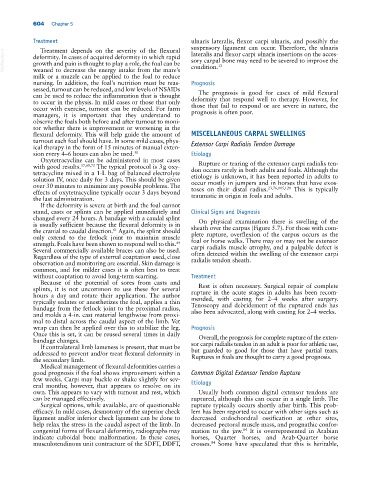Page 638 - Adams and Stashak's Lameness in Horses, 7th Edition
P. 638
604 Chapter 5
Treatment ulnaris lateralis, flexor carpi ulnaris, and possibly the
suspensory ligament can occur. Therefore, the ulnaris
Treatment depends on the severity of the flexural
VetBooks.ir deformity. In cases of acquired deformity in which rapid lateralis and flexor carpi ulnaris insertions on the acces-
sory carpal bone may need to be severed to improve the
growth and pain is thought to play a role, the foal can be
condition.
13
weaned to decrease the energy intake from the mare’s
milk or a muzzle can be applied to the foal to reduce
nursing. In addition, the foal’s nutrition must be reas- Prognosis
sessed, turnout can be reduced, and low levels of NSAIDs The prognosis is good for cases of mild flexural
can be used to reduce the inflammation that is thought
to occur in the physis. In mild cases or those that only deformity that respond well to therapy. However, for
those that fail to respond or are severe in nature, the
occur with exercise, turnout can be reduced. For farm
managers, it is important that they understand to prognosis is often poor.
observe the foals both before and after turnout to moni-
tor whether there is improvement or worsening in the
flexural deformity. This will help guide the amount of MISCELLANEOUS CARPAL SWELLINGS
turnout each foal should have. In some mild cases, phys- Extensor Carpi Radialis Tendon Damage
ical therapy in the form of 15 minutes of manual exten-
sion every 4–6 hours can also be used. 50 Etiology
Oxytetracycline can be administered in most cases
Rupture or tearing of the extensor carpi radialis ten-
with good results. 57,68,72 The typical protocol is 3 g oxy- don occurs rarely in both adults and foals. Although the
tetracycline mixed in a 1‐L bag of balanced electrolyte
solution IV, once daily for 3 days. This should be given etiology is unknown, it has been reported in adults to
occur mostly in jumpers and in horses that have exos-
over 30 minutes to minimize any possible problems. The 23,76,115,120
effects of oxytetracycline typically occur 3 days beyond toses on their distal radius. This is typically
traumatic in origin in foals and adults.
the last administration.
If the deformity is severe at birth and the foal cannot
stand, casts or splints can be applied immediately and Clinical Signs and Diagnosis
changed every 24 hours. A bandage with a caudal splint On physical examination there is swelling of the
is usually sufficient because the flexural deformity is in
the cranial to caudal direction. Again, the splint should sheath over the carpus (Figure 5.7). For those with com-
61
plete rupture, overflexion of the carpus occurs as the
only extend to the fetlock joint to maintain muscle
strength. Foals have been shown to respond well to this. foal or horse walks. There may or may not be extensor
49
carpi radialis muscle atrophy, and a palpable defect is
Several commercially available braces can also be used.
Regardless of the type of external coaptation used, close often detected within the swelling of the extensor carpi
radialis tendon sheath.
observation and monitoring are essential. Skin damage is
common, and for milder cases it is often best to treat
without coaptation to avoid long‐term scarring. Treatment
Because of the potential of sores from casts and
splints, it is not uncommon to use these for several Rest is often necessary. Surgical repair of complete
hours a day and rotate their application. The author rupture in the acute stages in adults has been recom-
mended, with casting for 2–4 weeks after surgery.
typically sedates or anesthetizes the foal, applies a thin
bandage from the fetlock joint to the proximal radius, Tenoscopy and debridement of the ruptured ends has
also been advocated, along with casting for 2–4 weeks.
and molds a 4‐in. cast material lengthwise from proxi-
mal to distal across the caudal aspect of the limb. Vet
wrap can then be applied over this to stabilize the leg. Prognosis
Once this is set, it can be reused several times in daily Overall, the prognosis for complete rupture of the exten-
bandage changes.
If contralateral limb lameness is present, that must be sor carpi radialis tendon in an adult is poor for athletic use,
addressed to prevent and/or treat flexural deformity in but guarded to good for those that have partial tears.
the secondary limb. Ruptures in foals are thought to carry a good prognosis.
Medical management of flexural deformities carries a
good prognosis if the foal shows improvement within a Common Digital Extensor Tendon Rupture
few weeks. Carpi may buckle or shake slightly for sev-
eral months; however, that appears to resolve on its Etiology
own. This appears to vary with turnout and rest, which Usually both common digital extensor tendons are
can be managed effectively. ruptured, although this can occur in a single limb. The
Surgical options, while available, are of questionable rupture typically occurs shortly after birth. This prob-
efficacy. In mild cases, desmotomy of the superior check lem has been reported to occur with other signs such as
ligament and/or inferior check ligament can be done to decreased endochondral ossification at other sites,
help relax the stress in the caudal aspect of the limb. In decreased pectoral muscle mass, and prognathic confor-
congenital forms of flexural deformity, radiographs may mation to the jaw. It is overrepresented in Arabian
84
indicate cuboidal bone malformation. In these cases, horses, Quarter horses, and Arab‐Quarter horse
musculotendinous unit contracture of the SDFT, DDFT, crosses. Some have speculated that this is heritable,
84

